#NOT ALL SEA SLUGS ARE NUDIBRANCHS
Explore tagged Tumblr posts
Text
I need to rant to someone about the taxonomy of soft-bodied marine gastropod molluscs
#NOT ALL SEA SLUGS ARE NUDIBRANCHS#and the subclass opisthobranchia is obselete since it was determined to be paraphyletic but the updated grouping euopisthobranchia doesnt#include sacoglossa or acochlidacea </3#which is booo bc elysia chlorotica are from the sacoglossa clade but are a 'sea slug' but are not nudibranches and there isnt a good term to#describe specialized complex soft-bodied marine gastropod molluscs aka sea slugs. its too broad grrr#they are all related in my heart of hearts
5 notes
·
View notes
Text
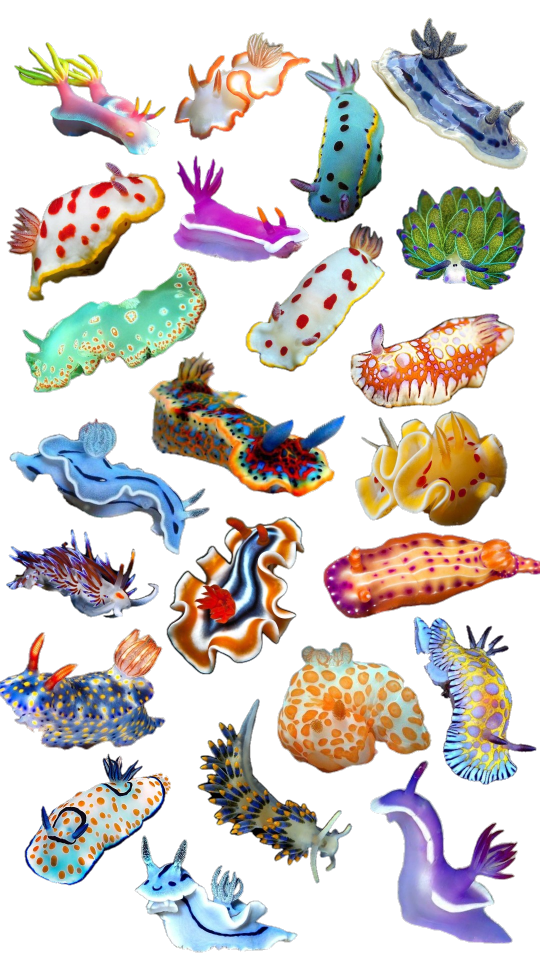
#png#transparent#animals#nudibranch#sea slug#fish#you all seem to like when i make collage / sticker sheet style posts#greatest hits#collage
18K notes
·
View notes
Text

sea bunny pincushion!!!



he's got a thin piece of plastic in the bottom of him, so that needles won't go all the way through. and if I do somehow get a smaller needle pushed all the way in, I can squeeze it and the plastic piece will push the needle back out through the top!
#...I also made the pattern for it and then proceeded to goof up sewing it in a really weird way???#which made the ridge around his sides extra scrinkly. which works out though because sea slugs are just like that sometimes!#his ears and tail are uneven but also very nice to fidget with. bouncy...#sea slug#bug#nudibranch#art#creature art#bug art#sewing#plushies#plushblr#marine invertebrates#sea bunny#sorry for adding 1billion tags to all my art posts. it is my very poor attempt at organizing them.#or at least making them findable.
17 notes
·
View notes
Text
Peltodoris atromaculata, commonly known as the sea cow

Image source: https://www.inaturalist.org/photos/29643924
8 notes
·
View notes
Text
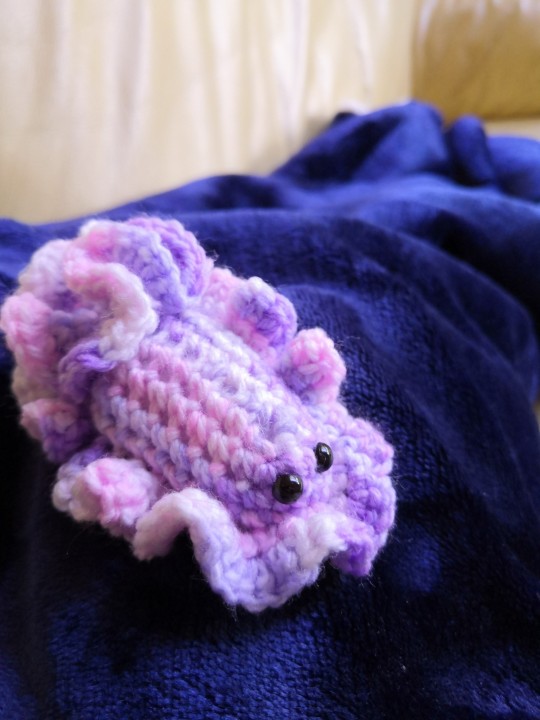
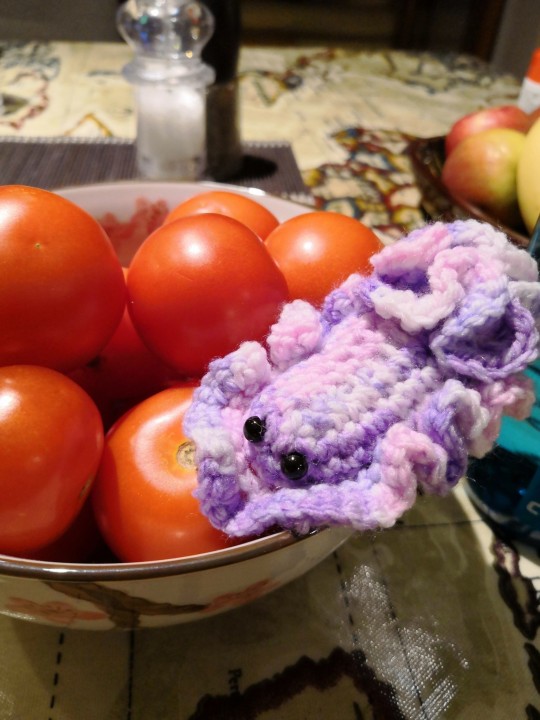
Wet beast Wednesday (dry edition)
#crochet amigurumi#crochet#sea slug#nudibranch#i made up this pattern on the fly#basic principles can take you a long way#that's the fun bit for me!#i dont mind ripping back a whole thing and truing a different way!#its all interesting!
80 notes
·
View notes
Text

#cliones arent nudibranchs but they are gastropods. theyre pteropods#sacoglossans arent nudibranchs either. but all of these can fall under 'sea slug'
4 notes
·
View notes
Text
absolute abysmal introduction post on my IT class. 2 months late and whatever i wrote is twice as long as everyone elses cuz i thought they were also gonna be that long. not only that, but instead of a picture of myself, i put a sea slug, then described why i liked that sea slug for 5 sentences, not knowing that in all the other non-person pictures people were posting, they straight up did not mention it, so their posts would just have a random picture of a car or someshit interjected in there with no mention that they liked cars or anything. chat what do i do to save this
#for reference i COULD NOT see anyone elses posts before i submitted my own. so thats why i wrote so much#cuz there were 5 things and i addressed all 5 things in their own section not knowing everyone else#wrote ONE SENTENCE for each thing#that sea slug btw was glossodoris rufomarginata incase you were wondering#also known as the white margin nudibranch or the caramel nudibranch
0 notes
Text

Ah yes, the average friend group: elbow squid, paranormal jelly and itty bitty sea slug. Hold on zoom in on the slug, I can't see it

There we go. I'm pretty sure these are my favourite sea creatures... They attend a silly oceanic college. Underdogs with no friends coming together. I might draw more of this concept in the future
Let me introduce them real quick


Lenny the bigfin squid (Magnapinna atlantica), he/they. Most awkward and shy guy around, gets bullied quite a lot and can't defend themself for the life of him


Pipi the Willan's chromodoris (Chromodoris willani), they/them. Very quiet and asocial, takes no bullshit from anybody, defending Lenny by their bullies every single time


Phanny the phantom jellyfish (Stygiomedusa gigantea), she/they. A weird aura surrounds them... Nobody wants to be on their bad side, though she's never been seen angry. Turns out she's just the local goth
#oc: lenny#oc: pipi#oc: phanny#PLEASE PLEASE PLEASE SEND ME ASKS ABOUT THEM PLEASE!!! THAT WOULD MAKE ME SO SO SO HAPPY#bigfin squid#magnapinna squid#phantom jellyfish#nudibranch#sea slug#chromodoris willani#stygiomedusa gigantea#squid#jellyfish#sea creatures#oc#my ocs#anthro#???????#well by definition they are but they dont look like your average furry at all. this is awkward#digital art#deedra's art
38 notes
·
View notes
Text
Because sometimes you just need to watch a nudibranch floof around the seafloor for an entire minute 🥰🤗
This relatively large sea slug (Tritonia tetraquetra) can grow to 22 centimeters (about eight inches) in length. The two horn-like structures on Tritonia's head are rhinophores that allow the sea slug to "smell" chemical signals dissolved in seawater and help find its prey��deep-sea corals. It crawls onto corals and eats the soft polyps using its rasp-like tongue, called a radula. Two rows of white fluffy gills line the back of this precious poof, and that pretty pink color comes from its rosy-hued prey. Also known as nudibranchs (pronounced “nood-i-branks”), this group of sea slugs lives in virtually all the world’s oceans, from the tide pools down into the deep sea. Unlike the dark, slimy relatives of the slugs we see in our gardens, they come in a wide array of bright colors and psychedelic patterns. Like many other deep-sea animals, the nudibranchs of the deep are poorly studied. Though scientists have named about 3,000 shallow-water nudibranchs, we have identified far fewer species that thrive in the deep ocean.
1K notes
·
View notes
Note
Hi Paxon,
IK this is a bit of a random ask but I just wanted to tell you how much I love seeing so many crestures on your blog every day! They're all so lovely and I like to research some of them in my spare time. It's always great to discover new critters. :D Thanks for all you do!
-Caelan 💫
Bless you my child, for you are on the sacred path (folowing me).
Here is a friend for you!!!

Green “Leaf Sheep” Sea Slugs (Costasiella kuroshimae), family Costasiellidae, found in coastal waters off of Indonesia, New Guinea and Japan
This marine gastropod engages in kleptoplasty, taking the chloroplasts from the algae that it eats, and using the chloroplasts for the waste products they create though photosynthesis. It’s kind of a… solar powered sea slug!
These "sea slugs" are not nudibranchs, but are in a different group of gastropods.
photograph by Alex Mustard Underwater Photography
#leaf sheep#sea slug#costasiella#costasiellidae#gastropod#mollusk#malacology#animals#nature#ocean#asia
380 notes
·
View notes
Text

Another excerpt from that Splatoon dev interview from a rare 2017 Nintendo dream issue, with some never before seen information. This one's. Interesting. Translation under the cut.
Q: What kind of sea slug is Flow based on? Inoue: Her coloration is based on what's called a cinderella sea slug* [[Hypselodoris apolegma]]. Traits from various other species of nudibranches were incorporated into her design. --- Nudibranches are hermaphroditic, so is Flow female? Male?
Inoue: Well...this magazine is called "Nintendo dream", so leave that to your fantasies (laughs). Nogami: After all, the Inklings can also freely change between girl and boy.**
*[[This species of nudibranch doesn't seem to have a common name in English. This is just a direct translation of the common name in JP.]]
**[[I chose this phrasing of "girl and boy" in reference to the player settings screen in s1 and s2, as that seems to be what Nogami is referencing.]]
#splatoon translations#splatoon#flow#splatoon 2#really a similar question had crossed my mind knowing about real life nudibranch anatomy#but i never expected to see anyone actually ASK about it. because that means youd be asking about a characters genitalia.#literally was like HUH?? when i first read this#i think they answered tactfully though LOL
320 notes
·
View notes
Text
It's 100% free and legal to google photos of sea slugs.










Hey, haha, for some reason everybody seems kinda stressed today.
Let's try to eke out a teeny amount of peace for ourselves. Here are some things that might help you regain a little bit of calm. Please feel free to reblog and add your own relaxing suggestions.
mynoise.net
Amazing website for white noise, with features that let you highly customize what you're hearing. Want to listen to a forest? A waterfall? A cafe? I highly recommend the Japanese Garden to relax and I use Distant Thunder to sleep at night. Consider donating, you can donate as little as $1 and get access to ALL the site's extensive features forever.
Lofi Girl
Chill background music. They have several live streams and even more video compilations based around different themes and moods. There are lots of Lofi channels out there, others will pop in your recommended videos, this is just the one I use most often.
Artificer
Full confession, I haven't played it yet but I found this while looking for cozy games and it looks adorable and I love the music and art already.
A couple pointless browser games for playing with color and light:
Neon Flames
Liquid Simulation
Silk
Again, please reblog with any relaxing suggestions, we can use every resource we can get.
Okay everybody, get your hot drink of choice (or a cold drink, I'm not the boss of you), settle in, and try to find a little bit of calm because what more can any of us do right now?
#sea slugs#nudibranch#These are all real animals can you believe it#There are still some parts of the world that are wonderful
56 notes
·
View notes
Text
Round 1 - Phylum Mollusca

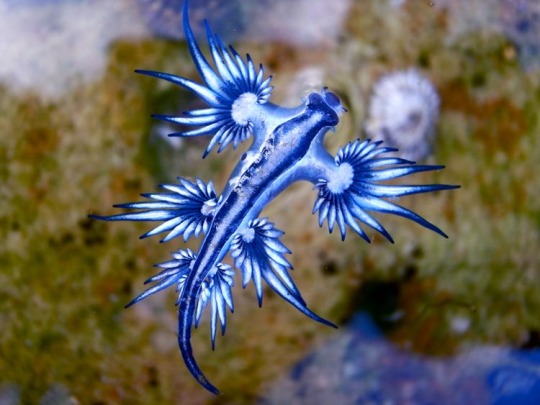

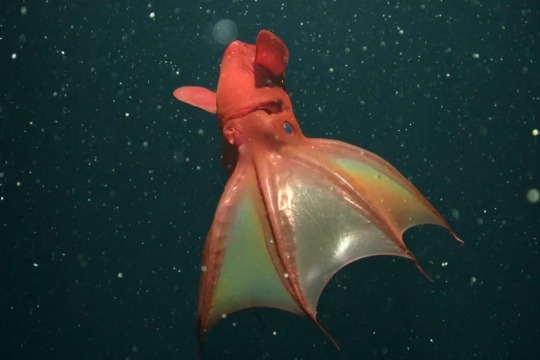
(Sources - 1, 2, 3, 4)
The second largest phylum, Mollusca contains over 76,000 living species and somewhere between 60,000 and 100,000 extinct species, including the ammonites and helcionelloids. Living groups include the chitons, solenogasters, caudofoveates, cephalopods (octopuses, squids, cuttlefish, nautiloids, etc.), scaphopods, gastropods (slugs and snails), and bivalves.
Molluscs are highly diverse, living on land, in freshwater, and in saltwater, where they comprise over 23% of all named marine organisms. The most diverse molluscs are the gastropods which comprise over 80% of known molluscs. Due to their high diversity, the only things most molluscs have in common are a soft body composed almost entirely of muscle, a mantle with a significant cavity used for breathing and excretion, the presence of a radula (bivalves excluded), and the structure of their nervous system.
Many molluscs are endangered due to collecting and killing individuals for their meat and/or decorative shells.

Propaganda under the cut:
Cephalopods are one of the (if not the) most neurologically advanced of all invertebrates and are capable of using tools, solving puzzles, and play.
Masters of camouflage, many cephalopods can change color, shape, and texture to hide from predators, sneak up on prey, and communicate with each other
The largest molluscs are the Giant Squid (Architeuthis dux), with 12–13 m (39–43 ft) long females and 10 m (33 ft) long males, and the Colossal Squid (Mesonychoteuthis hamiltoni) which is estimated between 10 m (33 ft) and 14 m (46 ft) long. The Giant Squid has much longer tentacles, but the Colossal Squid is heavier, reaching a mass of at least 495 kilograms (1,091 lb). The largest specimens of Colossal Squid, known only from beaks found in sperm whale stomachs, may perhaps weigh as much as 600–700 kg (1,300–1,500 lb).
Mollusc shells make up most of the “seashells” washed ashore, and are created by the animal via secretions of chitin and conchiolin from its mantle edge. Not all molluscs have shells (ex: nudibranchs) and for some, the shell is internal (ex: cuttlefish). Mollusc shells come in many beautiful colors, shapes, and sizes.
Most molluscs have eyes, and all have sensors to detect chemicals, vibrations, and touch. Of the phyla we have covered so far, their senses are the most developed.
Conchs can look at you like this:

(Source)
All cone snails are venomous, and some of the larger species are some of the most venomous animals in the world. Even though some species’ stings are fatal to humans, their sophisticated venom has saved lives through its use in neurological research.
Humans don’t just use mollusk meat and shells, but also luxuries like pearls, mother of pearl, Tyrian purple dye, and sea silk. As stated above, many species are now endangered due to human use, but some are farmed for their meat, pearls, and shells. The farming of bivalves is more ecologically-friendly than the farming of chordates as, rather than create waste, bivalves like mussels and oysters actually clean the water.
As filter-feeders, bivalves are natural water filters. A single 5.08 cm (2 inch) clam can filter up to 10-12 gallons of seawater a day. They can even filter microplastics out of polluted water.
The largest bivalve is the Giant Clam (Tridacna gigas) which can weigh over 200 kilograms (440 lb), measure as much as 120 cm (3.11 ft) across, and have an average lifespan in the wild of more than 100 years.
Cover your ears, kids. Terrestrial slugs, which are hermaphroditic, have some of the most intimate sex on the planet. A pair of slugs will suspend from a chord of mucus, heads down, and intertwine their bodies in a tight spiral. They will then evert their penuses and entwine them as well, exchanging sperm while hanging in midair. Slug porn, narrated by Sir David Attenborough, for your viewing pleasure.
#round 1#animal polls#we’ve reached my first personal favorite because cuttlefish are genuinely one of my all time favorite animals#mollusca
197 notes
·
View notes
Text










all my slugcats. i think they can retract limbs hence why some don’t have arms. slugs they are referenced from under the cut
(rbs appreciated)
survivor and monk: banana slug
hunter: red slug
gourmand: dusky arion slug
artificer - volcano / fire snail (not a slug but the colors were very arti)
rivulet - bennett’s nudibranch (sea slug)
spearmaster - bielvia slug
saint - green slug moth catipillar (not a slug but i think that fits saint)
nightcat / watcher - black velvet leatherleaf slug
enot / inv / ??? - no reference
#rain world#rw#rw survivor#rw monk#rw hunter#rw gourmand#rw artificer#rw rivulet#rw spearmaster#rw saint#rw nightcat#rw the watcher#rw enot#rw inv#rw sofanthiel#rw ???
211 notes
·
View notes
Note




So not technically a fish but I absolutely love these lil fellas
They’re Nudibranch sea slugs and they all look so pretty!!!!!


Some notable exception are the Sea Bunny (left) which is just the most adorable thing I’ve ever seen
And the Leaf Sheep (right), which is the only animal known to be capable of photosynthesis!
i am SUCH a nudibranch fan oh my god. actual underwater fae creatures. beloved little freak animals. i want to eat them like cereal

204 notes
·
View notes
Text
Marine biology nerd reacts to Wuthering Waves fishing minigame! Part 2
Your resident biology major who loves sea critters is back with another post on the obtainable fish in the fishing minigame in Wuthering Waves 🐟🌊 Since my last one got significant positive reception!
First off for this post, we have...
Til the Fin-ish

"Til the Fin-ish" is based on the kissing gourami, a special kind of fish with an extra joint in its jaw that allows it extra dexterity in scraping algae and other nutrients from substrate. It also uses its highly mobile jaws to spar with its conspecifics, though the reason behind this particular form of aggression is still not well understood. This "kissing" behavior makes it popular in aquariums, hence the leucistic (light pink) morph on which the version in Wuthering Waves is based!

(Image source)
I'm not very well-versed on pop culture references, so I couldn't immediately find anything to which the name "Til the Fin-ish" (and the associated in-game tagline) might be a reference... though if anyone has any leads, I would be delighted to hear about a potential source! 👀✨ It is an edible fish -- though I'm not sure how widely available it is from a culinary standpoint -- so there is indeed a nonzero chance you might find yourself in a situation wondering whether you "finished" a couple of this fish.
Pricklecrab

The pricklecrab is almost definitely based on the king crab, a family of crabs known for their covering of prominent spines. Surprisingly, they are in the same superfamily as hermit crabs! As such, they are not necessarily "aggressive predators" like their in-game counterparts; hermit crabs are omnivorous scavengers, not predators.

(Image from NOAA, in the public domain)
Incidentally, some kinds of king crabs do get pretty big -- a large red king crab (Paralithodes camtschaticus) can weigh up to 28 pounds -- so if you, hypothetically, did pick up and throw a king crab at your enemies, I imagine it could deal quite a bit of damage. Being able to grab it in the first place would probably be the most difficult part of the whole process!
Bogie Shrimp

The Bogie Shrimp is likely based on Anomalocaris, a genus of extinct marine arthropod that lived roughly 500 million years ago. I've seen them discussed a few times on Tumblr, so you might be familiar with this little guy already!

(Image source)
Superficially, Anomalocaris is pretty similar to the Bogie Shrimp, with a couple of key differences: first, the bogie shrimp is much larger than Anomalocaris probably ever was. Estimates put the largest known Anomalocaris specimen at a maximum length of about 50cm; the one I've found in-game is more than twice that size! (Still, 50cm is considered enormous by Early-to-Middle-Cambrian standards, so the vibe, at least, is accurate.) Second, Anomalocaris did not have "razor-sharp fangs," or even teeth at all; its mouthparts probably operated by suction and were certainly not strong enough to penetrate exoskeletons, so, while indeed carnivorous, it almost definitely fed exclusively on soft-bodied prey.
And then, one final critter -- I have again saved my favorite of the bunch for last...
Seabed Snow

The "Seabed Snow" is based on the nudibranch, more colloquially known as a sea slug! While they are mollusks, they lack shells in their adult forms. They have rhinophores (chemosensory, i.e. smell/taste), organs on the front end that look like little ears or antennae, and gills on the rear end, which, put together, makes them quite adorable. There are over 3,000 identified species of nudibranchs that come in all kinds of different shapes and colors, and they live in oceans all over the world, so they are quite a varied group when it comes to appearances!
Seabed Snow are on the large side for nudibranchs; most nudibranchs are pretty tiny -- maybe a couple of inches or so, so they can be surprisingly hard to spot! -- but the very largest nudibranchs can get to lengths of about 60cm, which matches my in-game "biggest catch" of 63cm.
Seabed Snow is likely based specifically on the giant white nudibranch (Doris odhneri), which is found primarily on the west coast of the United States. (How do they say it... "west coast represent?") Granted, this guy is not really all that giant, only reaching lengths of about 20cm tops. Otherwise, the resemblance is pretty spot-on!

(Image from NOAA, in the public domain)
As much as I'd love to wax poetic about nudibranchs, I'll wrap up my post there today! I do have one more post in this series I'd like to make later, so keep an eye out for that. 🐟✨
Part 1 -- Part 2 (you are here) -- Part 3
38 notes
·
View notes